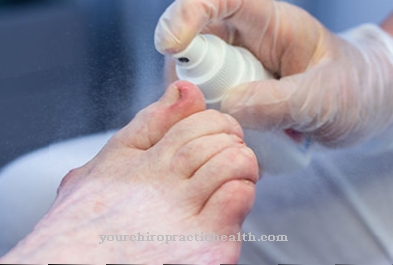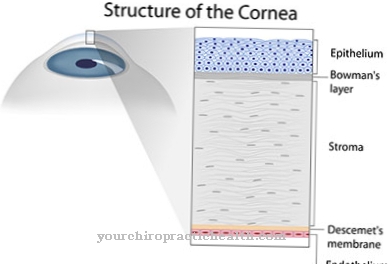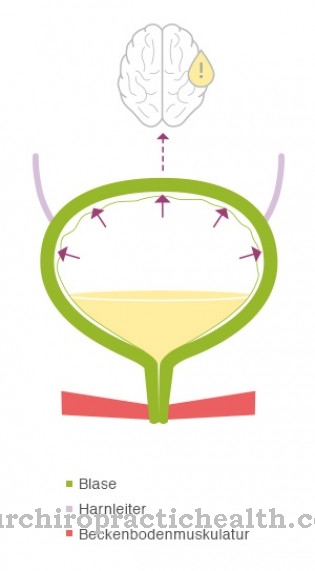Normally, wounds heal with intact wound healing in such a way that scar tissue remains. However, over time this area hardly stands out from the healthy area. This is different with a so-called Bead scarthat can be an aesthetic impairment.
What is a bulge scar?

A Bead scar is also called in medical terminology Keloid designated. In contrast to "healthy" scar tissue, the bulge scar is distinguished by its raised appearance that protrudes above the skin surface.
Under these conditions, a bead scar can be clearly recognized. A bulge scar can also cause discomfort under certain conditions.
This is often the case when a bulge scar has developed on an internal organ tissue. The bead scar, which can harden, creates permanent friction. In addition, bulge scars require additional space and can exert pressure on adjacent organ areas.
causes
The etiology or causes of the formation of a Bead scar are not yet fully known. It is assumed that the causes are increased growth of the so-called keloid, which is triggered by an overactivity of the fibroblasts involved in wound healing.
In addition, there are more factors that affect the formation of a bead scar. These include, for example, the cytokines and the body's own substances that promote cell growth, as well as the macrophages and the cell structures known as epidermal keratinocytes.
There is likely to be an imbalance between these components, creating more collagen as the basis for the bulge scar. A certain genetic readiness of the organism can contribute to an increased tendency to bulge scars.
Symptoms, ailments & signs
Bulge scars are an outward appearance that can disfigure those affected. However, bead-like, shaped scar adhesions can also result from operations inside the body. Both types of scarring can cause accompanying symptoms that are undesirable. Bulge-like scars often lead to feelings of tension or pressure on vessels and nerves. A bulge scar is reddened and raised for a long time.
Typical symptoms that can cause bulbous scars include itching, pressure and tension, or pain around the wound area. The fresh scar tissue will only soften after several months or years. It often gradually takes on a normal color. Bulge scars caused by burns or surgical interventions can remain sensitive to sunlight or pressure for a long time after they have healed. You may be in constant pain.
Sometimes an internal bulge scar develops during biliary surgery. This puts pressure on a discharging or feeding vessel. This can lead to vascular occlusion and colic. The problem is that every further operation leads to new adhesions.
External bulge scars represent a cosmetic problem, but also a medical problem because of the accompanying symptoms. Sometimes an operative correction is necessary. The scar formation in burn and acid victims is particularly problematic. This is where painful bulging scars often develop, which require special treatment approaches and many cosmetic operations.
Diagnosis & course
A Bead scar is always benign can be recognized purely externally by its nature. A bulge scar that has formed inside the body after an operation causes corresponding discomfort and can be recognized by an X-ray or ultrasound examination.
A bulge scar, which develops after defects through burns, acne or vaccinations, manifests itself in many cases as persistent itching and even a certain pain. The boundaries of the bulge scar are not smooth and do not merge evenly into the surrounding intact tissue.
If a bulge scar occurs in a draining or supplying vessel (bile duct), occlusions with accompanying colic can occur. Dermatologists can recognize a bulge scar just visually and can differentiate it even better with a magnifying instrument.
Complications
If a bulge scar develops, it is primarily a cosmetic problem for those affected. Complications can arise if there is no medical treatment for the scar. Those affected then often develop inferiority complexes and no longer dare to show their bodies.
If there is no therapeutic support, these emotional complaints can develop into full-blown anxiety disorders that have a significant impact on the lives of those affected. A bulge scar can also cause physical problems. Most of the time, the noticeable skin changes are associated with sensitivity to touch.
Many of those affected are sometimes sensitive to the weather - a condition that is associated with recurring pain and has a very negative effect on well-being. The constant itching can cause those affected to scratch the scar and cause an infection. In the worst case, this can lead to blood poisoning.
Most of the time, scratching will cause the scar to enlarge. A drug treatment with cortisone can cause side effects in rare cases. Major complications are possible with a surgical procedure. Surgical measures, for example, carry the risk that the surrounding tissue structures will be damaged. Wound healing disorders and infections can also occur.
When should you go to the doctor?
An external bead scar can look very unsightly. It can put a lot of strain on people who experience it. This is especially true when a bead scar is in the visible area.
However, bulbous scars can also become inflamed or lead to growths. The latter is particularly often the case with postoperative scar growth in the abdomen. Doctors then speak of an adhesions. Another operation would presumably generate new scar tissue here. Nevertheless, surgical repair of internal bulge scars may be indicated in the case of severe complaints. The bulging scars that occur after back operations can trigger feelings of tension. They can press on vessels or nerve cords.
The psychological stress caused by a reddened bead scar in the field of vision can be considerable. Bulge scars are both cosmetically and medically relevant problems. A doctor's visit is always indicated if depression or other complaints arise as a result of a bulge scar. The doctors responsible are, depending on the situation, a psychologist or a cosmetic surgeon. The latter can remove the unsightly bulge scar through an operation. A new scar that is less prominent then arises in the same place.
In the event of severe burn injuries or after acid attacks, there is an increased formation of bulge scars. Interdisciplinary help may be necessary here. Although elastic face masks can reduce scarring, many cosmetic surgeries are inevitable.
Treatment & Therapy
A Bead scar can not only be treated but also removed. In this context, it is precisely those scars that are located on clearly visible parts of the body that are bothersome and annoying. In addition, with the treatment of the bead scar, the associated complaints can also be brought under control.
A scalpel does not always have to be used with a bulge scar. A scar on the skin surface can also be treated with medication or with creams and ointments. Another way of making a bead scar "invisible" is to use what is known as cryotechnology. The direct effect of very low temperatures leads to an inhibition of cell growth in the bulge scar. Injections of cortisone to reduce the visibility of the bulge scar are also successful.
Laser devices are among the most modern methods used in dermatology and aesthetic medicine to treat a bulge scar. Both the fractional and the ultra-pulsed carbon dioxide laser treatment are important here. Surgical correction of the bulge scar through reoperation can also be useful.
prevention
As part of the homeopathic measures, a Bead scar can be prevented by the intake of vitamin E. The best prophylaxis against a bulge scar are, of course, intact and smooth wound healing and professional wound care.
In addition, as a prevention against a bulging scar, a fresh scar should not be exposed to excessive UV rays. Applying friction and pressure to a wound that has just healed should also be avoided. By "keeping a scar supple", a new formation of scar tissue in a bulge scar can also be prevented. The use of special scar plasters is also recommended against a bulge scar.
Aftercare
Aftercare for a bulge scar focuses on finding appropriate treatment options. Most scars can be treated with creams and ointments, laser therapies such as carbon dioxide laser treatment, or cryotherapy. Surgical removal of the scar is also possible. After the treatment is over, the dermatologist will examine the affected areas of the skin.
A visual diagnostic examination and a subsequent conversation with the patient can be used to determine whether the result meets expectations. Depending on this, further steps can then be planned. If no further treatment is possible because the bulge scar is already too tightly knotted or is on a sensitive part of the body, therapeutic advice is often useful for the patient.
Otherwise, the aesthetic flaw can lead to inferiority complexes and make it difficult for the person concerned to freely show his body. Follow-up care focuses on carrying out the treatment and follow-up treatment of the bulge scar together with the patient. It is usually taken over by the responsible dermatologist or the family doctor. Depending on how the bulge scar develops, further doctor's appointments may be necessary. In other cases, the bulge scar stagnates and the patient decides against further treatment.
You can do that yourself
A bulge scar is usually only a problem for the patient if it is painful or bothersome, but medically nothing can be done about it. If the bulge scar is inside the body, there are limits to what you can do to help yourself.
However, external scars that bother the patient can be smoothed and relieved with patience and appropriate creams. Various scar creams and oils are available in pharmacies and drugstores. Only he himself can find out which is the right one for the patient. It is important that he can apply the product to the scar area and massage it in gently. Experience has shown that gels are not suitable for this. The patient should take time twice a day for the gentle massage. After applying lotion, the tissue can be loosened and moved with the fingertips until it is warm and well supplied with blood. It may take weeks or even months for the scar to become soft and supple, but consistent self-treatment can relieve the itching and make the tissue pain-free again. At the same time, the patient learns to see the scar as part of his body and to accept it.
If the bulge scars are subjectively cosmetically disturbing, psychotherapeutic intervention can help to cope better with them. If the scars are objectively disfiguring, regular visits to a self-help group can help. The treating physicians can offer appropriate addresses.


.jpg)



.jpg)






.jpg)

.jpg)
.jpg)











.jpg)